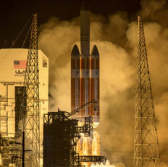 A NASA space probe designed by the Johns Hopkins University Applied Physics Laboratory for solar exploration has received an innovation of the year recognition from Popular Science magazine.
A NASA space probe designed by the Johns Hopkins University Applied Physics Laboratory for solar exploration has received an innovation of the year recognition from Popular Science magazine.
The Parker Solar Probe flew on August 12 and came to within 15 million miles of the sun’s surface while traveling at a speed of 153.4K mph, Johns Hopkins APL said Thursday.
“The mission is the culmination of years of focused, inspired work by hundreds of people at the laboratory and at our partner institutions,” said Ralph Semmel, APL director.
The space probe used a cooling system and a thermal protection framework to shield itself from radiation and heat while an automated computing platform performed complex data calculations to maintain safe flight parameters.
Parker will upload its collected data through the Deep Space Network on Dec. 7 and is scheduled to approach the sun’s surface 24 more times from as close as 4 million miles and at a speed of 430,000 miles per hour.




